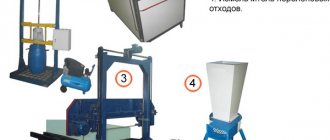New technologies in business make it possible to produce and sell unique products that would have been unthinkable even in the last decade. Business ideas in the field of IT technologies are attractive because when introducing a new product to the market, you can set a large markup until analogues appear and the market is saturated. Therefore, in this business it is important to make quick decisions and monitor all promising new products and services on the market. This section presents innovations in production, design, construction, and information technologies that will help organize a profitable and quickly payback business.
How to stand out from your competitors
The opening of any enterprise and the identification of a niche must be accompanied by a study of consumer demand and potential markets for the results of labor.
There are many companies specializing in the same activities, but every successful business entity has a secret that sets it apart from its competitors. Simple ideas with a little improvement turn into unique ones. Innovations are effective if they are aimed at transforming the way the results of work are promoted. Today, such progressive methods as vending, front-end and vending are known.
Vending
A great idea to advertise your offer is a vending scheme. Its essence lies in the sale of products through a machine. In this way, you can sell any objects of a traditional and specific nature. Convenient sales of coffee, tea, soft drinks, fruits, sweets and chewing gum. A good example of the popularity of vending and the possibility of selling specific goods using this scheme is the sale of live crabs through vending machines in Japan.
Factors of development, improvement and implementation of production technologies
The development of production technologies and innovation depends on several factors:
- Staff. To achieve sustainable results, it is necessary to attract qualified and trained personnel. This is the only way to satisfy consumer needs in a short time.
- Means of labor. These include various kinds of material objects with which you can create products or provide services. Such means include various equipment and tools, apparatus, computers, cars, tractors, and complex machinery. Natural resources, such as water, are important. Thanks to such means, natural components are transformed into useful products.
- Subject of labor. It is a collection of things that are used by people to satisfy their needs. They are divided into two categories. The first includes natural elements that have not undergone special processing, and components that have undergone processing.
- Information. This factor is one of the most important. It is information that plays a connecting role in the production and promotion of goods. Even if you have trained and professional personnel, high-quality equipment and labor items, it is impossible to achieve success without having information about supply and demand, about the general situation on the market.
Formed competencies
- Formulates, within the framework of the identified problem, goals, objectives, relevance, significance (scientific, practical, methodological and other depending on the type of project), expected results and possible areas of their application (SS-1.1)
- Predicts the results of project activities. Forms a schedule for the implementation of the project as a whole and a plan for monitoring its implementation (SS-1.2)
- Organizes and coordinates the work of project participants, promotes constructive resolution of emerging disagreements and conflicts, ensures the work of the team (SS-1.3)
- Presents publicly the results of the project (or its individual stages) in the form of reports, articles, speeches at scientific and practical conferences, seminars, etc. (SS-1.4)
Rationalization of production
Risk factors in innovation activities
Manufactured products become obsolete, and the consumer becomes fed up with them. Therefore, the manufacturer must constantly work to improve its offer, monitoring sales indicators and striving to ensure their compliance with the overall demand for the product in the region of its promotion. Each product has its own life cycle, consisting of:
- implementation of the proposal;
- ensuring production using innovative technology;
- increasing demand;
- maturity due to peak sales;
- decline in interest.
Changing consumer preferences and competition are significantly shortening product life cycles. A company that does not strive for improvement is forced to give up its position to dynamically developing enterprises, whose managers pay attention to the modernization of the technologies used and the results of their work.
If an entrepreneur makes every effort to improve production, but cannot achieve stable results, then he needs to think about a new sales market, since only from this perspective can we talk about the possibility of stable development.
The product life cycle is not very high. Due to the many similar proposals, its obsolescence occurs quickly. To maintain positions in a competitive market, innovative marketing activities are carried out. They are aimed at improving product quality, introducing new developments and timely discontinuation of outdated products and replacing them with new offerings.
Technologies for the production of milk and dairy products
Dairy products are one of the most popular. In every supermarket you can buy milk, fermented milk products, various yoghurts, cottage cheese, cheese and butter. Dairy products have always been in demand, so development in this area of production is a very promising direction.
For the production of dairy products, dried and whole cow's and goat's milk, as well as its products (cream, whey), are used.
The production technology is schematically as follows:
- raw materials are prepared;
- milk and cream are standardized according to the percentage of fat content;
- heat treatment and homogenization are carried out;
- the product is cooled to a certain temperature;
- fermented milk products are fermented.
Fermented milk products can be produced by two methods: thermostatic and tank. In the first case, whole milk is first purified, normalized, and sterilized. The product is cooled and fermented. The resulting milk is poured into packages and sent to fermentation chambers. At the final stage, the product must be cooled and kept for about 12 hours.
In the second case, processes such as fermentation and maturation are carried out in special production tanks, and only after that the finished product is bottled. This technology involves cleaning, heating to 72 degrees and pasteurization. Only after this the product is aged and sent for further processing.
Then the milk is cooled and fermented for 3-7 hours. Once the product has reached the required acidity, it is cooled again and packaged. I would like to note that this production method is much more economical than the thermostatic method. In addition, the quality of dairy products produced by the tank method is much higher. That is why this method is used most often.
Business technology
Currently, there is no clear and unambiguous definition of the concept of “business technology”; it (the concept) is rather vague and applicable to the most diverse actions. But at the same time, there is no doubt that business technologies exist as a phenomenon, which is quite large-scale, popular, applicable in practice, and sometimes clearly structured.
If we still assume that the “decoding” of the term is important, then the concept of business technology can most likely be accurately defined in the following words - this is a set of methods, techniques, innovations, technical and mental solutions that contribute to the development of business, expand its capabilities and create for him new perspectives.
Currently, there are many business technologies that can be called justified, well-established and internationally recognized. At the same time, new mechanisms and developments continue to appear and, as it seems, the process of development of such technologies has no designated end.
Business Technology Goals
The tasks assigned to this type of methodological discipline come down to the functions of promoting commercial activity in those segments of the market process that were inaccessible to it in the traditional form of doing business.
The objectives of the technologies under consideration can be specified as follows:
- Finding innovative solutions in the relationship between business and consumer.
- Optimizing income through non-standard forms of interaction with other participants in the market environment.
- Increasing staff efficiency.
- Development of new types of business strategies.
- Search for unconventional ways to enhance marketing effect.
This list can be continued and detailed, but the whole essence of business technologies ultimately comes down to helping to increase business profits, which is the raison d’être of the latter’s very existence.
The most famous business technologies
Let us consider here several types of business technology, which at one time had the status of “know-how”, but have justified themselves historically and are now, in fact, integral phenomena of the economy:
- Franchising. The essence of this entrepreneurial interaction is that a company that has improved its technologies, conquered the market to a certain extent, achieved marketing success and created a brand, expands its profits due to a kind of passive income. It invites lesser-known commercial entities to take advantage of the business system it has already formed, adopt proven methods and conduct their activities on behalf of this company, while remaining an independent entity. Such interaction is usually mutually beneficial, since the franchisee (buyer of the brand) uses an already proven scheme, and the franchisor (company with the brand) receives income (royalties) from the sale of the franchise (license).
- Leasing. This technology has significantly expanded the scope of lending, as it has provided the parties with the opportunity to transfer credit relations to a new level. The essence of leasing is that one party acquires certain property and transfers it for use to the other party, who ultimately must make regular payments in favor of the lessor. If this technology was previously applicable exclusively in the sphere of relationships between legal entities, now so-called consumer leasing is becoming increasingly widespread.
- Outsourcing. This type of business technology has allowed large-scale companies to ease the internal organizational burden by shifting it onto the shoulders of their counterparties. The meaning of the interaction is that the company delegates certain functions or parts of the business to a contractual entity, who takes over the organization of this segment of activity, while it concentrates the use of its production and human resources on achieving higher business goals. For example, a company transfers accounting management to third-party specialists or entrusts the maintenance of its information systems to other persons on a contract basis.
- Factoring. Like leasing, the business technology in question has simplified the activities of structures related to lending. In cases where there are receivables that adversely affect the possibilities of financial turnover, factoring allows you to “sell” this debt on commission terms to a third party. In such cases, the company promptly replenishes its liquid assets and reduces the cost of maintaining accounts, while the other party to factoring receives a profit in the form of full repayment of receivables.
You can supplement this list with such world-famous technologies as crowdsourcing, crowdfunding, outstaffing, and so on, but there is no point in listing all successful business technologies, because they are just a sample, not a paradigm.
The latest trends in the development of business technologies
Like any other form of social activity, business technologies are subject to the influence of general progress and technical innovations. If previously such a technology as video marketing was impossible due to the non-existence of video recording itself, now it has been implemented on a full scale throughout the world and is used by millions of enterprising people. Just like advertising products using videos, other technological methods for business development are emerging.
The main place is now occupied by the so-called electronic commerce (or electronic business), when with the help of interactive networks new opportunities are achieved not only in marketing or trade, but also in the movement of funds, consumer banking and even services, from crafts to insurance. This is an example of how industrial technologies become assistants to business technologies, allowing previously local business projects to be transferred to a global environment.
At the same time, business technologies develop on their own and without the involvement of modern technical innovations, as exemplified by the so-called co-marketing, a recently emerged concept when market participants join their efforts to promote products. Increasingly, manufacturers of often different services are creating advertising alliances, thereby, as it were, exchanging consumer audiences. The process of improving old business technologies also continues, when already familiar outsourcing is constantly taking on new forms, gradually turning into separate holistic areas.
To summarize, it can be noted that business technologies are not only existing methods of non-standard business development, but also a constant and dynamic search for new solutions based on commercial experience and deep knowledge of market mechanisms.
Benefits and Features
With the proper approach, business in the field of IT technology has a number of advantages:
- there is always a client who is willing to pay;
- regular increase in demand for IT products;
- absence or relatively low requirements for the amount of starting capital;
- development prospects.
In addition to the obvious advantages, the idea of opening an online business is notable for the fact that company employees can work remotely, being in different parts of the world. This not only makes cooperation more convenient, but also allows you to select only qualified personnel from around the globe.
Learning outcomes
- Formulates, within the framework of the identified problem, goals, objectives, relevance, significance (scientific, practical, methodological and other depending on the type of project), expected results and possible areas of their application (RO-1).
- Predicts the results of project activities. Forms a schedule for the implementation of the project as a whole and a plan for monitoring its implementation (RO-2)
- Organizes and coordinates the work of project participants, promotes constructive overcoming of emerging disagreements and conflicts, ensures the work of the team (RO-3).
- Presents publicly the results of the project (or its individual stages) in the form of reports, articles, speeches at scientific and practical conferences, seminars, etc. (RO-4)
Light industry
The tasks of the light industry include the introduction of scientific and technological progress in the field of clothing, leather goods and other industries.
Corporate information system
To successfully compete with Chinese firms, prompt exchange of information data is very important. One enterprise often has many divisions located at large distances from each other. The corporate information system is an open, integrated mechanism for automating all work processes of the company at all levels. It allows you to exchange data within the structure and interact with suppliers. Also, this system warns about all sorts of problems in production and the current state of affairs.
3D design
For several years now, developments have been underway on three-dimensional computer design of clothing. Special programs allow you to perform spatial modeling aimed at creating “infused” wardrobe items. All construction parameters are edited and saved for future use. The three-dimensional design method is highly accurate and, obviously, is the future.
Electronic meters
One of the new technologies in light industry is electronic meters. They are designed for remote measurement of client parameters. This thing greatly simplifies the work. In addition, both parties save their time, which is very important in the modern rhythm of life.
Automatic fabric cutting
The leather goods and clothing industries have begun to use computer-aided design to automatically cut fabric. This allows you to quickly and efficiently simulate the necessary things. Such a system has become an integral part of clothing and footwear enterprises. It improves the quality of product fit, reduces the labor intensity of routine processes and speeds up the process of creating new models.
Modern materials
New materials have unique characteristics. For example, microfiber has become very popular recently. It has the following advantages:
- strength;
- airtightness;
- distribution of static electricity;
- resistance to light and chemical influences.
It is also used for the production of children's clothing, since its qualities are comparable to natural fabrics.
A new technology for the production of artificial fibers has become widespread in the textile industry. Polyamide materials repel moisture and absorb fat, but are durable and wear-resistant. Viscose fabrics made from high modulus fibers have good hygienic properties. They are smooth, lightweight, and have an attractive appearance.
Another innovation is the production of textiles based on nanomaterials. Such fabrics have the following properties:
- thermal conductivity;
- dirt repellent;
- waterproof;
- ability to conduct electricity.
Services
What exactly each company employee will do depends on the specific IT idea for the business. The form of service provision is also chosen at the discretion of the entrepreneur, taking into account the specifics of the direction. If we talk about freelancing, then before starting work, it would be a good idea to acquire a portfolio so that the client can be convinced of the competence of the performer and entrust him with the work.
Among the companies, customers especially highlight those whose employees are not only regularly in touch during working hours, but are also ready to organize a business meeting to clarify questions about the services provided.
Development trends in the IT field
Currently successful IT business ideas will be in demand for a long time only if they adapt to new times and technologies.
Technological progress does not stand still, so over the years, qualified IT specialists will be increasingly needed, and the ways of interacting with information will also not remain unchanged.
Business ideas in the IT field: how to choose a promising idea?
Defining a working framework is fairly easy if you consider the needs of digital users. Even an idea that is not in demand today may become promising in the future. One way to determine what will be in demand in the future in our country is to look at the work of our Western colleagues. It is no secret that most successful domestic startups are a successful adaptation of an idea already existing abroad. If at first glance you cannot determine whether your idea will work, you can look for inspiration on foreign thematic portals.










